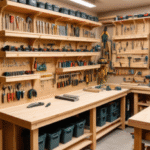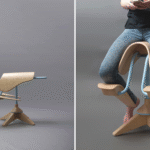The Beauty and Blunders of Classic Woodworking
You know, there’s this kind of magic that happens when you dive into classic woodworking. It’s one of those things that draws you in without you really realizing it. I mean, there I was, sitting in my garage one Saturday morning, surrounded by the smell of sawdust and the sound of my table saw humming. I had the warmth of my coffee on one side and my latest project—a vanity—on the other. Little did I know, it was about to turn into a rollercoaster ride of learning and regretting and, eventually, some satisfaction.
The Dream Vanity
So, the idea kicked off innocently enough. My wife, bless her heart, was scrolling through Pinterest late one night, and she stumbled across this stunning vanity. It had painted white legs with a dark walnut top, and it was so classic yet modern at the same time. “Oh, wouldn’t this look great in our bathroom?” she exclaimed, and you know how it goes. Next thing I knew, I was sketching designs on a napkin.
I decided to use some poplar for the legs. It’s cheap enough on a tight budget but still looks good when stained right. The top? I decided to go with a nice walnut slab. Nothing beats the smell of freshly cut walnut when you’re sanding it down. It’s like heaven every time I take a whiff. But the problem? I went in a little too gung-ho—didn’t really think about how delicate the poplar could be.
The First Cuts…and Errors
Now, I don’t want to paint myself as some kind of woodworking whiz. I’m just a regular guy, you know? As I began cutting the legs on my miter saw, I realized I was getting too comfortable, too quickly. I thought, “Yeah, I got this.” And let me tell you, the very first leg I attempted? A complete disaster. I forgot to account for the clearance for the floor, and the darn thing ended up about an inch too short. I remember just staring at it in disbelief, coffee cup dangling from my fingers. Almost made me want to toss it in the corner and call it quits for the day.
Instead, I took a break. You know, sometimes you just gotta let the frustrations simmer. I stepped outside, took a deep breath of that fresh morning air, and sat down on the porch for a minute, letting the quiet seep in. After a while, I went back to the garage with a clear head. I decided I could fix it; I would just clamp a piece of scrap wood to extend the length. A little wood glue, a little doweling, and voilà! It was like the little leg that could.
Tackling the Top
Fast forward a bit, and I finally had the legs where I wanted them—clean joints and a good fit. Now came the top. I found a walnut slab that was absolutely gorgeous at the local lumber mill; it had all these tones of rich chocolate and caramel. I was so proud walking out of there like I’d just won the lottery.
But when it came to trying to join the walnut to the poplar legs, I faced my next hurdle. It turns out walnut can be unruly when it comes to staining. I’d spent hours sanding it down to a silky smooth finish, but then when I applied my first coat of oil, I was greeted with this splotchy disaster. I’ll never forget the moment my heart sank; it looked like a bad tie-dye job. I almost laughed just to keep from crying.
After that screw-up, I had to hit the books—well, more like watch a couple of videos on wood finishing and how to avoid blotching. They recommended using a pre-stain conditioner, which, honestly, I hadn’t even thought of. I ran out and grabbed a can, crossed my fingers, and gave it another shot. And wouldn’t you know it? Turned out beautifully. I was almost doing a little dance in my garage when I saw it finally even out into that rich, deep color I was dreaming of.
The Finishing Touches
With the legs and top finally coming together, I moved on to the hardware and all those glorious little details. I decided on some antique bronze knobs to add that classic touch. I found them online and, honestly, that moment when I held them up to the finished piece was pure gold—like I was finally seeing the light at the end of the tunnel.
But can I just say one thing? Installing hardware isn’t as easy as it looks. I messed up the drill alignment not just once, but three times! Each time I had to plug the holes with some wooden dowels, sand them down, and start over. The noise of that drill screeching through the wood always sent shivers down my spine. But I kept telling myself it was all part of the journey. I laughed at myself—like, who knew I’d turn into a wooden surgeon mid-project?
The Reveal
Finally, after what felt like an eternity, I stood back to admire it. With the sun pouring through the garage door, hitting that walnut just right, I had to stop for a second and really take it in. There was my vanity, standing strong and proud. Flaws and all, it was unique, and it had character—much like everything else we make with our own hands.
That night, when we moved it into the bathroom, I could hardly believe how well it fit. My wifeooed over it like it was a long-lost friend, and that moment made all the hours spent sweating in the garage totally worth it.
So, if you ever feel like diving into something a little daunting, whether it’s woodworking or whatever else, just remember: it’s okay to mess up. Believe me, I did it a thousand times. But every misstep is a lesson, and every victory—even the small ones—is just as sweet. The real magic isn’t in the final piece but in the whole process of creating it. So go ahead and get your hands dirty. You might just end up surprising yourself.










